The AMD Radeon R9 290X Review
by Ryan Smith on October 24, 2013 12:01 AM EST- Posted in
- GPUs
- AMD
- Radeon
- Hawaii
- Radeon 200
Company of Heroes 2
Our second benchmark in our benchmark suite is Relic Games’ Company of Heroes 2, the developer’s World War II Eastern Front themed RTS. For Company of Heroes 2 Relic was kind enough to put together a very strenuous built-in benchmark that was captured from one of the most demanding, snow-bound maps in the game, giving us a great look at CoH2’s performance at its worst. Consequently if a card can do well here then it should have no trouble throughout the rest of the game.
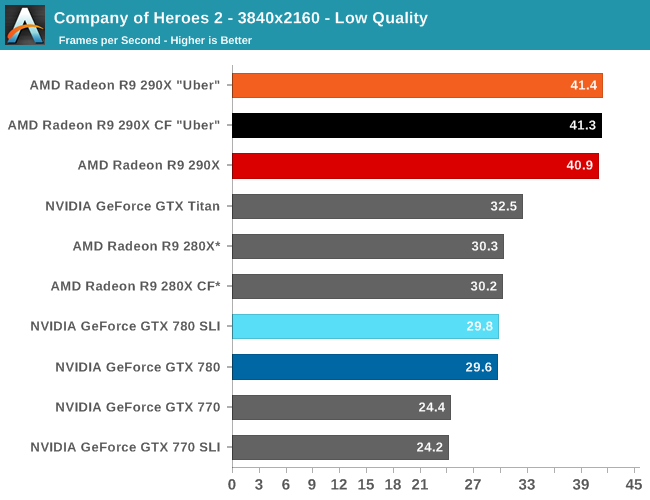
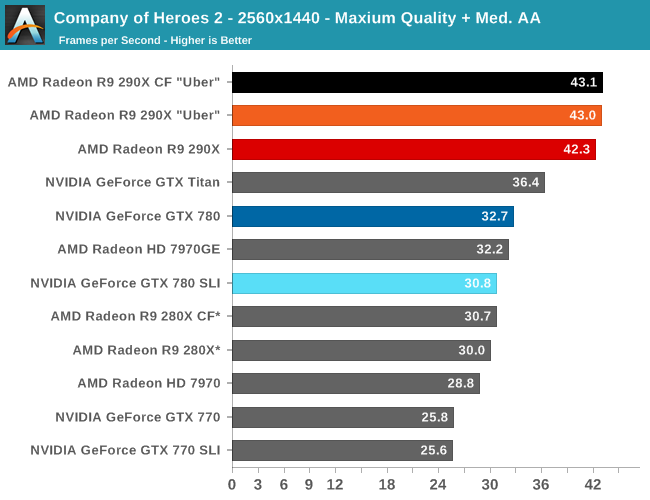
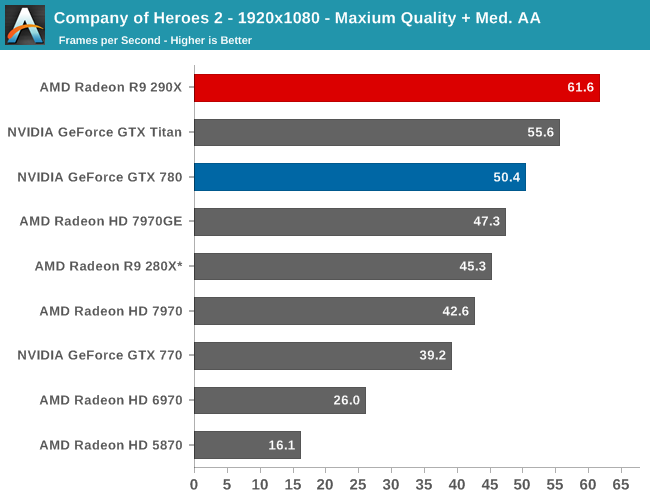
Our first strategy game is also our first game that is flat out AFR incompatible, and as a result the only way to get the best performance out of Company of Heroes 2 is with the fastest single-GPU card available. To that end this is a very clear victory for the 290X, and in fact will be the largest lead for the 290X of all of our benchmarks. At 2560 it’s a full 29% faster than the GTX 780, which all but puts the 290X in a class of its own. This game also shows some of the greatest gains for the 290X over the 280X, with the 290X surpassing its Tahti based predecessor by an equally chart topping 41%. It’s not clear what it is at this time that Company of Heroes 2 loves about 290X in particular, but as far as this game is concerned AMD has put together an architecture that maps well to the game’s needs.
Briefly, because of a lack of AFR compatibility 4K is only barely attainable with any kind of GPU setup. In fact we’re only throwing in the scale-less SLI/CF numbers to showcase that fact. We had to dial down our quality settings to Low on CoH2 in order to get a framerate above 30fps; even though we can be more liberal about playable framerates on strategy games, there still needs to be a cutoff for average framerates around that point. As a result 280X, GTX Titan, and 290X are the only cards to make that cutoff, with 290X being the clear winner. But the loss in quality to make 4K achievable is hardly worth the cost.
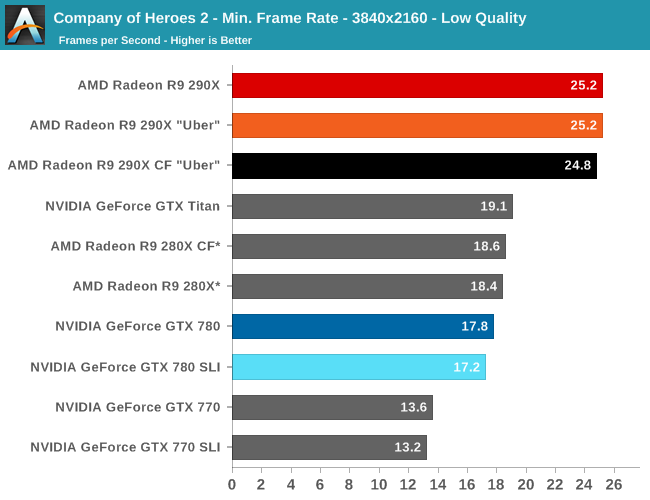
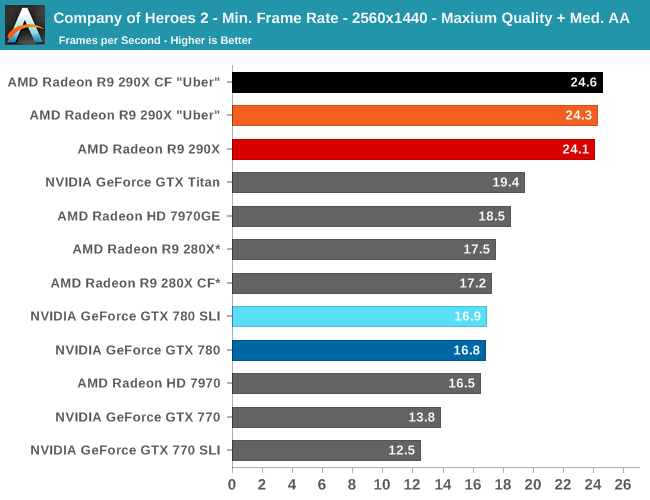

Moving on to minimum framerates, we see that at its most stressful points that nothing, not even 290X, can keep its minimums above 30fps. For a strategy game this is bearable, but we certainly wouldn’t mind more performance. AMD will be pleased though, as their performance advantage over the GTX 780 is only further extended here; a 29% average performance advantage becomes a 43% minimum performance advantage at 2560.
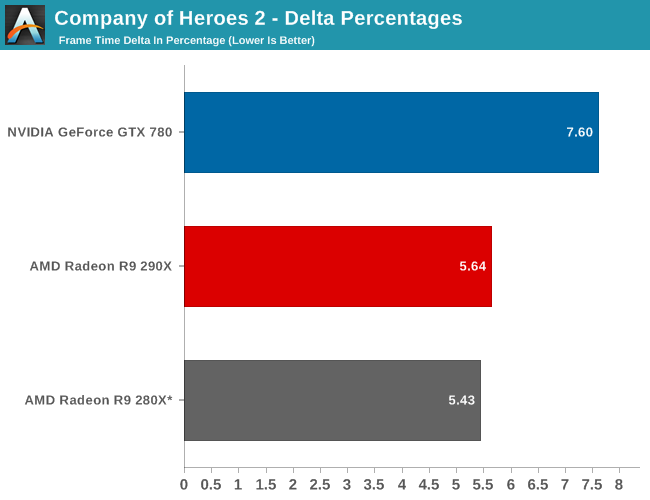
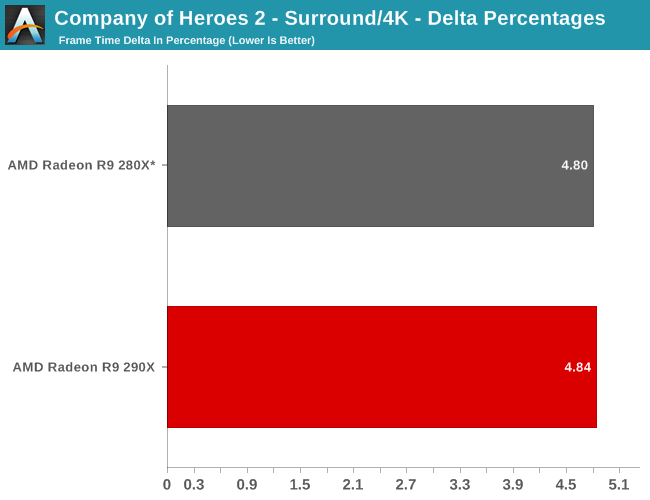
Finally, while we don’t see any performance advantages from AFR on this game we did run our FCAT benchmarks anyhow to quickly capture the delta percentages. Company of Heroes 2 has a higher than average variance even among single cards, which results in deltas being above 5%. The difference between 5% and 7% is not going to be too significant in practice here, but along with AMD’s performance advantage they do have slightly more consistent frame times than the GTX 780. Though in both the case of the 280X and the 290X we’re looking at what are essentially the same deltas, so while the 290X improves on framerates versus the 280X, it doesn’t bring with it any improvements in frame time consistency.










396 Comments
View All Comments
rituraj - Saturday, October 26, 2013 - link
So that "PROSUMER" cookie that nv tried to sell was just a grandma's cookie and it's proven now. I will buy the next maxwell flagship AND AT $600. (Lol.. I have to pay 20% more here in India)dazaj - Friday, October 25, 2013 - link
why is there no titan sli in all these benches but there is 290x cfRyan Smith - Friday, October 25, 2013 - link
Because we only have 1 Titan.just4U - Friday, October 25, 2013 - link
They likely didn't have two on hand..dazaj - Friday, October 25, 2013 - link
why is there no titan sli in any of these benchesdrinkperrier - Friday, October 25, 2013 - link
Just 1 question.Can i have the possibility to buy this videocard from AMD brand and not asus, sapphir and etc??
Ryan Smith - Friday, October 25, 2013 - link
Unfortunately no. AMD does not directly sell Radeon cards to consumers. They only directly sell Radeons to OEMs, while FirePros are directly sold to everyone.rituraj - Saturday, October 26, 2013 - link
The best thing I can get out of this release is that nVidia is not going to be able to charge $1000 for its next flagship or ultra-flagship. Because it's been proven that no matter what crazy performance it gives, it can be released at a 500-600 range by AMD and therefore by nVidia too. Even if they do, charge that much people will j7st wait for a few months for AMD to release an equally powerful card at 600 or 500. Good move AMD...SunLord - Saturday, October 26, 2013 - link
Saturday and I'm still not sure the reviews done or at least Anandtech has dropped making explaining and commenting on test resultspolaco - Saturday, October 26, 2013 - link
Origin PC will loose lots of possible sells by having dropped AMD. NVidia monopolistic friends pay the consequences...